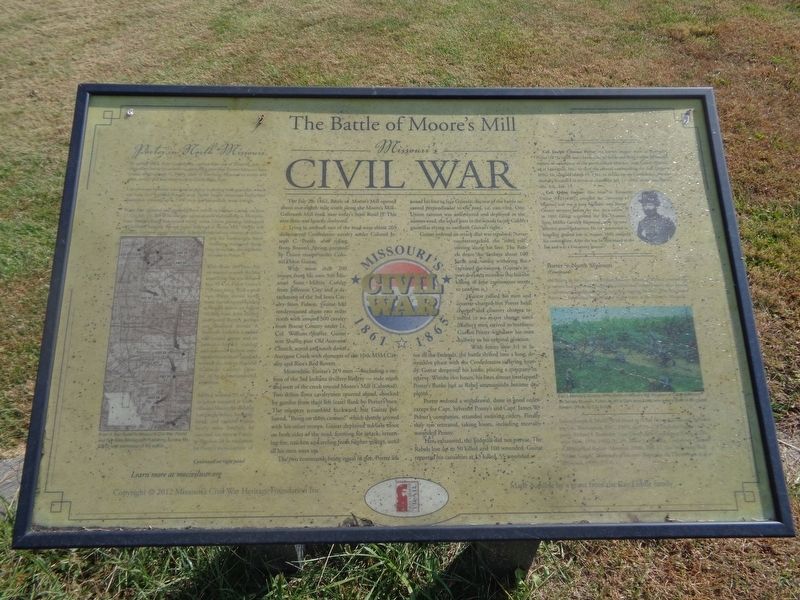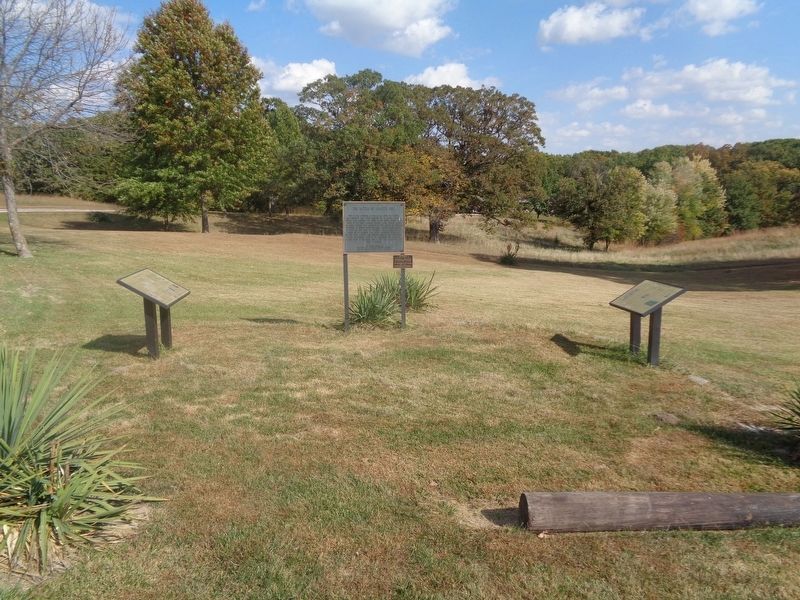Near Calwood in Callaway County, Missouri — The American Midwest (Upper Plains)
The Battle of Moore's Mill
Missouri's Civil War
— 1861-1865 —
Lying in ambush east of the road were about 260 dismounted Confederate cavalry under Colonel Joseph C. Porter, after riding from Brown's Spring pursued by Union troops under Colonel Odon Guitar.
With more than 200 troops from his own 9th Missouri State Militia Cavalry from Jefferson City and a detachment of the 3rd Iowa Cavalry from Fulton, Guitar had rendezvoused about two miles north with around 500 cavalry from Boone County under Lt. Col. William Shaffer. Guitar sent Shaffer past Old Auxvasse Church, across and south down Auxvasse Creek with elements of the 10th MSM Cavalry and Rice's Red Rovers.
Meanwhile, Guitar's 269 men - including a portion of the 3rd Indiana artillery battery - rode south and west of the creek toward Moore's Mill (Calwood). Two dozen Iowa cavalrymen spurred ahead, shocked by gunfire from their left (east) flank by Porter's men. The troopers scrambled backward, but Guitar bellowed, "Bring on them cannon!" which shortly arrived with his other troops. Guitar deployed soldiers afoot on both sides of the road, forming for attack, returning fire, stricken and reeling from further volleys, until all his men were up.
The two commands being equal in size, Porter adjusted his line to face Guitar's; the rest of the battle occurred perpendicular to the road, i.e. east-west. One Union cannon was unlimbered and deployed in the narrow road, the other west in the woods facing Cobb's guerrillas trying to outflank Guitar's right.
Guitar ordered an attack that was repulsed; Porter counterattacked, the "rebel yell" stirring along his line. The Rebels drove the Yankees about 100 yards and under withering fire, captured the cannon. (Guitar's report does not mention this but the killing of four cannoneers seems to confirm it.)
Guitar rallied his men and counter-charged but Porter held; charges and counter charges resulted in no major change until Shaffer's men arrived to reinforce Guitar. Porter withdrew his men halfway to his original position.
With forces now 3:1 in favor of the Federals, the battle shifted into a long, destructive phase with the Confederates suffering heavily. Guitar deepened his ranks, placing a company in reserve. Within two hours, his lines almost overlapped Porter's flanks just as Rebel ammunition became depleted.
Porter ordered a withdrawal, done in good order - except for Capt. Sylvester Penny's and Capt. James W. Porter's companies, stranded awaiting orders. Finally they too retreated, taking losses, including
mortally wounded Penny.
Hot, exhausted, the Federals did not pursue. The Rebels lost up to 50 killed and 100 wounded. Guitar reported his casualties at 13 killed, 55 wounded.
Porter in North Missouri
By spring 1863, most Confederate regulars were out of Missouri, now occupied by Union forces bent on controlling guerrillas. Former Missouri State Guard officer Joseph C. Porter came to Northeast Missouri to recruit and train cavalry and lead them back to Confederate lines.
Union troops followed a no-quarter policy in dealing with guerrillas, which was how they regarded Porter's men. Porter fought numerous battles and skirmishes, enlisting up to 2,000 men; few successfully made it south.
Porter first captured and paroled Union militia in Marion County on June 17. On July 13, 200 of his recruits captured arms and clothing in Memphis. Some undisciplined men looted stores, and a Union man was kidnapped and believed hanged. Savage fights followed at Vassar Hill, Florida and Santa Fe. Union General John M. Schofield ordered out citizens at militia, and his increasingly harsh measures motivated foraging by militia, driving many recruits to Porter.
With about 260 men, Porter wanted to reach the Missouri River, but was defeated here by Col. Odon Guitar's 733-man force. With a small core, Porter moved northward, recruiting and fighting at Newark before, on August 16, Brig. Gen. John McNeil confronted Porter's perhaps one thousand recruits at Kirksville with five hundred well-trained troops and six cannon. McNeil crushed and scattered Porter's command. About three hundred crossed the river at Portland (Callaway County) October 16 on a commandeered steamboat.
McNeil ordered 25 of Porter's men executed at Kirksville and Macon; he said they had fought before, been captured, and violated Union loyalty oaths. Similarly, he executed ten men at Palmyra October 18 in retaliation for Porter's men's capture of and failure to free Unionist civilian Andrew Allsman. McNeil asserted his prisoners had previously fought the Union and violated oaths after parole. Confederates argued otherwise, indelibly tagging McNeil "The Butcher of Palmyra"; locals have long referred to the event as the Palmyra Massacre.
Col. Joseph Crisman Porter: Born in Kentucky, Porter (1819-1863) was a Lewis County father and farmer when he became captain of a company of the pro-Southern Missouri State Guard. Wounded at Lexington, Mo., he then was colonel commanding the 2nd Division MSG. He resigned March 19, 1862, to recruit for the Confederacy. He was mortally wounded in action at Hartsville Jan. 11, 1863, dying near Batesville, Ark., Feb. 19.
Col. Odon Guitar: Also born in Kentucky, Guitar (1825-1907) attended the University of Missouri and was a state legislator and Boone County attorney before the war. As a colonel, in 1862 Guitar organized the 9th Missouri State Militia Caalry Regiment, who became effective guerrilla hunters. He was promoted to brigadier general but in August 1864 resigned his commission. After the war he continued in the law and was a University trustee.
Erected 2012 by Missouri Civil War Heritage Foundation Inc. and the Ray Liddle family.
Topics and series. This historical marker is listed in this topic list: War, US Civil. In addition, it is included in the Missouri’s Civil War series list. A significant historical date for this entry is March 19, 1862.
Location. 38° 54.69′ N, 91° 50.987′ W. Marker is near Calwood, Missouri, in Callaway County. Marker is on State Highway JJ, 0.6 miles south of State Highway Z, on the right when traveling north. Touch for map. Marker is at or near this postal address: 4039 State Hwy JJ, Fulton MO 65251, United States of America. Touch for directions.
Other nearby markers. At least 8 other markers are within 6 miles of this marker, measured as the crow flies. A different marker also named The Battle of Moore's Mill (here, next to this marker); a different marker also named The Battle of Moore's Mill (here, next to this marker); The Battle of Moore's Mill Mass Grave (approx. 0.6 miles away); Battle of Moore's Mill Memorial (approx. 0.6 miles away); Jones Tan Yard - 1820 (approx. 1.2 miles away); Old Auxvasse Cemetery (approx. 2.7 miles away); Grant's Stage Stand - 1821 (approx. 4.7 miles away); Fulton Country Club (approx. 6 miles away). Touch for a list and map of all markers in Calwood.
Also see . . . Battle of Moore's Mill on Wikipedia. (Submitted on October 16, 2022, by Jason Voigt of Glen Carbon, Illinois.)
Credits. This page was last revised on October 16, 2022. It was originally submitted on October 15, 2022, by Jason Voigt of Glen Carbon, Illinois. This page has been viewed 203 times since then and 57 times this year. Photos: 1, 2. submitted on October 15, 2022, by Jason Voigt of Glen Carbon, Illinois.

